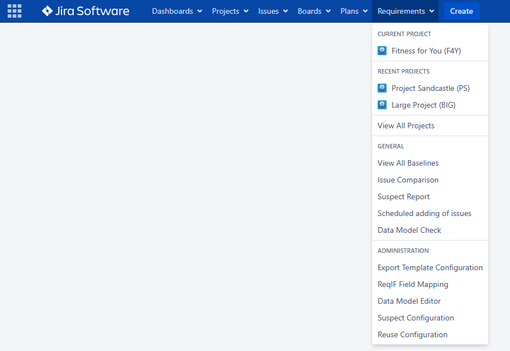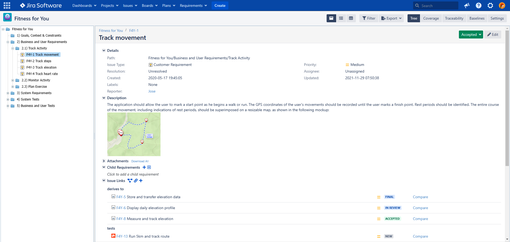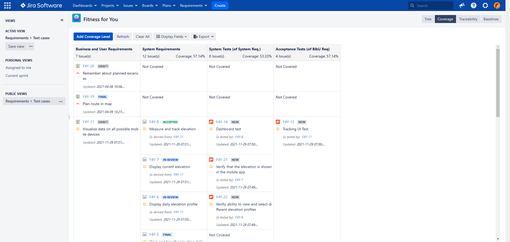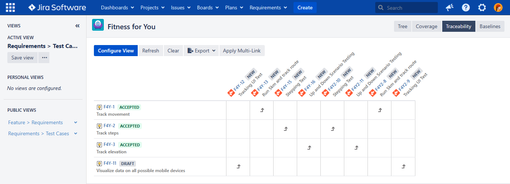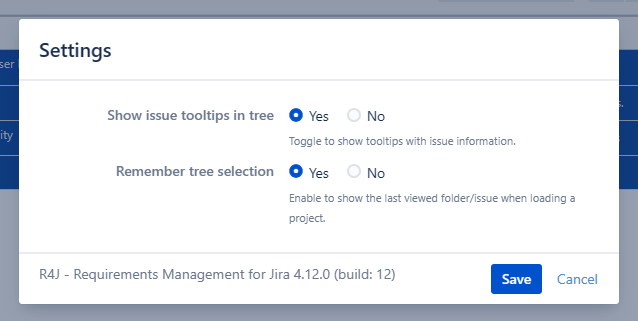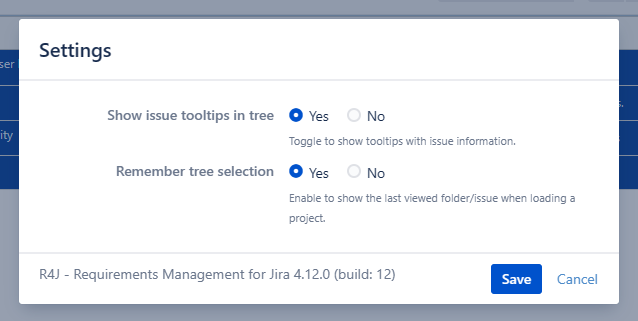Main Navigation Bar
R4J adds a new menu item Requirements to the main navigation bar.
The menu
provides access to the most important
features of R4J:
Menu entry | Purpose |
|---|---|
Current Project |
Shows the last project that was used by the logged in user. | |
Recent Projects |
Lists the last projects that were used by the logged in user. | |
View All Projects |
Opens a list of projects that are enabled for R4J. |
View All Baselines |
Lists |
baselines created for R4J projects. |
Issue Comparison |
Compares two Jira issues side-by-side. | |
Suspect Report |
Shows a filtered list of suspect links across projects. | |
Scheduled adding of issues |
Lists rules to schedule the creation of issues by project. |
Data Model Check | Checks Jira data against the configured data model. |
Export Template Configuration |
Manages uploaded export templates. | |
ReqIF Field Mapping | Creates field mappings for ReqIF import and export (dark feature). |
Data Model Editor | Creates data model rules between issues and links (dark feature). |
Suspect Configuration |
Configures suspect logic. | |
Reuse Configuration |
Reading View
The primary view of R4J is the Reading View, which allows you to organize requirements into folders and view them in the relevant context. To open the view, select a folder from the tree.
Tabular View
The Tabular View displays the contents of a folder as a flat list. To open the view, select a folder and then click the table button to switch from the reading view to the tabular view.
Configures standards for requirement reuse. |
| Info |
|---|
Dark features (also known as feature flags) are features not enabled by default. In R4J’s case, these flags are used for features still under development or undergoing beta testing. Access to dark features can be provided by R4J Support. |
Tree View and its sub-views
The tree view comprises of the tree hierarchy on the left side, and a sub-view content display on the right side.
When clicking a folder, issue, or page in the tree hierarchy, there is an option to switch between 3 types of views based on how you want to review the item. These are the detail view, reading view, and tabular view buttons respectively.
The selected sub-view is persisted per item type for efficiency.
Detail View
The Detail Viewis the default view for issues. It includes all the information of the selected issue: summary, description, other fields, attachments, child requirements, issue links and revisions, along with workflow actions.
Reading View
The Reading View is the default view for folders. It allows you to review requirements and folders in their relevant context.
Tabular View
The Tabular View displays the contents of the selected tree item as a flat list.
Coverage View
The Coverage View provides insight into the consequences of requirement changes. It also shows how complete the coverage is. For example, the view can show whether all features have corresponding requirements. To open the view, select the Coverage button and then select a specific view. See Coverage View to learn how views are created.
Traceability View
The Traceability View provides a matrix showing the relationships between two sets of issues. To open the view, select the Traceability button and then select a specific view. See the Traceability Matrix to learn how views are created.
Settings
The Settings Dialog allows you to enable or disable the following settings:
tool tips in the tree view
the remember feature for tree navigation
Issue Key Hyperlinks
Issue keys inside the application redirect to the tree view if the issue is located in any R4J activated project.
If the issue is located in multiple projects, a project selector dialog will pop-up which will allow you to select which project you want to be redirected to.
If you want to go to the Jira issue view directly, click on the link icon found at the top right of the issue key on hover:
